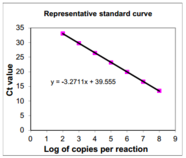HSV-1 Real Time PCR
Virusys Corporation’s HSV-1 qPCR 20x probe mix is a reliable probe for measuring relative amounts or total copy numbers of HSV-1 by quantitative PCR. The probe consists of forward and reverse primers combined with a FAM/BHQ-labeled probe specific for glycoprotein D (gD) of HSV-1. This dual-labeled probe is supplied with PCR primers at 20x concentration and may be used with standard real-time PCR reagents.
 For absolute copy number calculations, a tube of standards is also included containing the target sequence at 1012 copies per ml. These standards produce linear results at dilutions of 108 to 102 copies per reaction.
For absolute copy number calculations, a tube of standards is also included containing the target sequence at 1012 copies per ml. These standards produce linear results at dilutions of 108 to 102 copies per reaction.
Download Instructions
Influenza A NCP ELISA (Photometric)
Influenza viruses can be divided into three classes, A, B, and C, largely based upon conserved antigenic differences in the internal nucleoprotein. Influenza A virus, typically encountered more frequently than types B and C, and associated with the majority of serious epidemics, can be further subdivided into strains or subtypes based on antigenic differences in the external hemagglutinin proteins (H1-H16) and neuraminidase proteins (N1-N9).
A variety of wild waterfowl appear to be the predominant natural reservoir for Influenza A viruses and subtypes representing many of the hemagglutinin and neuraminidase combinations can be found circulating in these birds. Historically, human influenza virus infections have been associated with H1N1, H2N2, and H3N2 subtypes of influenza A, although a recent (1997) and significant outbreak in Hong Kong was identified as an H5N1 subtype.
















